| Columns Retired Columns & Blogs |
The Audeze LCD-X, Fazor, and a Fresh Listen to the Current LCD-2 and LCD-3 Page 2
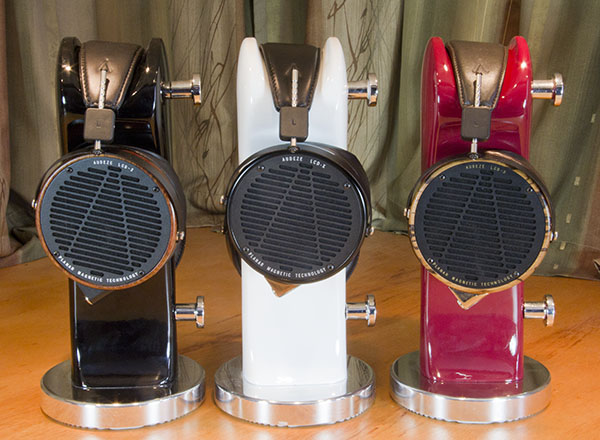 Audeze Headphone Changes Over Time
Audeze Headphone Changes Over Time
I decided to dig into the many headphone measurement spreadsheets I've acquired over the last three years since starting InnerFidelity and compare the numerous models tested. A couple of things to note: Some of the traces for early models of the LCD-3 are an average of three or four headphones; the FR traces of these models will be somewhat less noisy in the treble due to the averaging of multiple cans response. Also, please remember that headphone measurements are notoriously difficult, and while I try to be very careful the data is not 100% reliable. So please, don't try to read too much into these data, especially above 5kHz where many factors come into play.
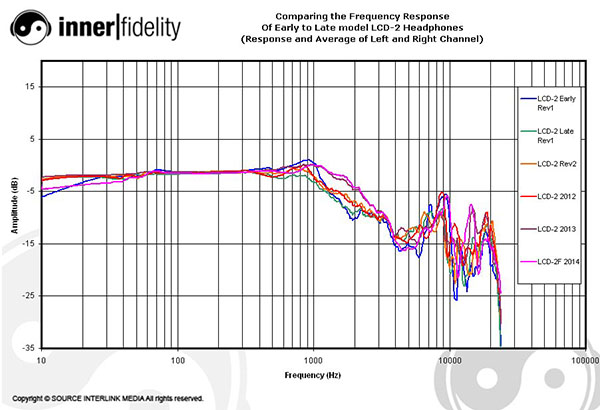
In the compensated frequency response plots above we see the evolution of the LCD-2. Probably the most important area of change is between 400Hz and 3kHz. This is an area critical to the proper reproduction of the human voice and its overtones. I really wish we had proper target curves to help guide our view here, but my understanding leads me to think that we don't want to see a precipitous drop after 1kHz, but rather more flat to 2kHz then gently sloping down thereafter to 10 or 15dB down at 20kHz...of course in the real world things get pretty wonky above 5kHz and you'll never see a flat line up there. Anyway, it's pretty obvious that the LCD-2 has been on a trend to make the transition after 1kHz more gentle and to lift the 1-3kHz area. Above 10kHz one can't read too much into things, but it does seem the later headphones have somewhat more energy than the older models.
To my ears in listening over the years (I don't have many of the earlier LCD-2s at hand) the LCD-2 does seem to have moved away from their earlier warm glow, and are now markedly more neutral to my ears. The sound of the old LCD-2s certainly played toward my personal dalliance with "creamy" sounding cans, but I do recognize it as a flaw in my aural personality, and genuinely prefer a more neutral and articulate headphone for serious listening. I think the current LCD-2 does a much better job in this area than previous versions. More on the LCD-2 when we start comparing cans in the Audeze family.
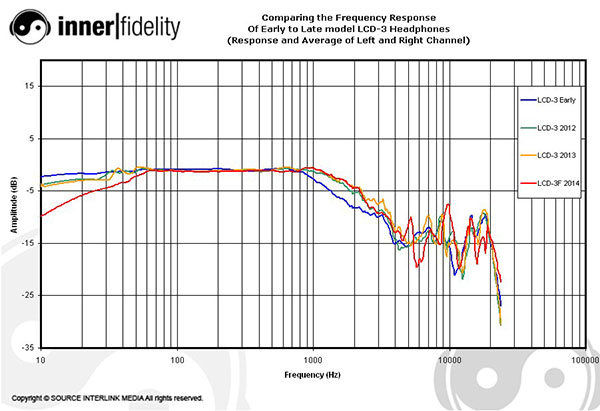
The LCD-3 has not changed quite as much over time...it's not been around as long, of course. Here we see the early LCD-3 with a plot similar to the LCD-2 Rev. 2 of its time. Subsequent LCD-3s have moved to a similar curve as the Latest LCD-2 in the above plot.
One thing that's a bit concerning to me is the latest can's tendency to drop off in the bass. The latest LCD-3, and to a lesser extent the latest LCD-2, show a modest loss of some bass extension. Some of these differences may be pad materials, but I did hear the LCD-X and LCD-2F hitting a just a little harder on the low thumps.
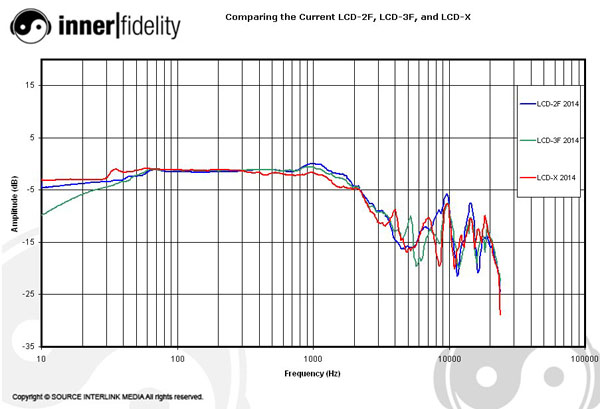
Above is a compensated frequency response plot for all three current models with Fazors. Of note are the differences in low bass—and I 'm a little skeptical of the measurements accuracy here; pad material differences between the three models interacting with the artificial materials of my measurement head may be at play. My guess is they perform more similarly on real heads with acoustic leaks due to hair and such. None the less, the LCD-X did seem the punchiest of the bunch in the lows.
Another area of note is the differences between 800Hz and 2kHz. I do hear the LCD-2 as being a bit harder and grittier, and the LCD-X as being a bit smoother in this presence region that tends to emphasize consonant sounds.
Lastly, in the treble region above 3kHz, the LCD-2 has a distinct dip at 5kHz and a peak at 10Khz while the LCD-3 and LCD-X have a lot more up-and-down motion. These rapid peaks and valleys seem to me more likely to originate in various resonances in the ear-cup and my guess is that the actual energy emitted from the headphones is quite a bit flatter. My point is that while these two seem more hurky-jerky in this area, they may actually be flatter than the larger excursions of the LCD-2. Lotta guessing going on here, though.
In listening I heard the LCD-3 as the smoothest; the LCD-2 as slightly grainy; and the LCD-X as...well, more neutral sounding...having less "character" than the other two.
Driver Differences
I spent some time talking on the phone with Alex Rossen, CEO of Audeze, about the differences in drivers in the three models. Most of it, as you might guess, is proprietary information, but there are a couple of tid-bits I can share:
- Diaphragm materials are slightly different in all models but the LCD-X and LCD-XC which use the same material.
- The magnetic structure is similar on the LCD-3, LCD-X, and LCD-XC; the LCD-2 is substantially different.
- Damping varies in each model.
- The circuit design (the pattern of traces on the diaphragm) are all different. It's obvious from my conversation that this is a particularly interesting area of ongoing developement.
Listening Tests
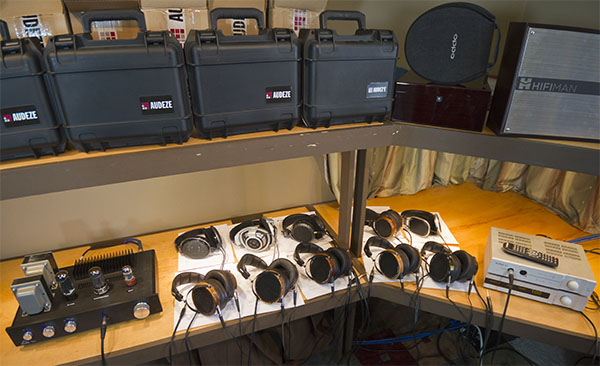
Sometimes my job is just awesome! To the far left is the Apex Hi-Fi Audio Teton single-ended, OTL headphone amp/pre-amp ($5000). To the right is my trusty stack of AURALiC gear, the TAURUS Mk2 headphone amp and VEAGA DAC. In the middle, headphones left to right, top row: Sennheiser HD 650; Sennheiser HD 800; HiFiMAN HE-500; HiFiMAN HE-560; Oppo PM-1. Bottom row, left to right, all Audeze headphones: LCD-3F; LCD-3; LCD-2; LCD-2F; and LCD-X. About $22,000 worth of headphone geek toys!
The bulk of my listening was done comparing the current Fazor models agains each other, and compared with LCD-2 and LCD-3 models just prior to the Fazor change. I've mentioned some tid-bits regarding the sound quality above, but I'll reiterate here in more detail.
First, all three headphones in their current form are quite similar tonally. Gone are the days of uber-buttery sound for Audeze, I find the current models be pretty well balanced with the mid-treble range and up being stronger and in better proportion than previous Audeze incarnations. I hear the LCD-2 now as being a little grainier and less refined in the treble than the other two, but significantly improved over previous iterations. The LCD-3 sounds nicely refined and clear with a bit of liquid goodness thrown in. The LCD-X seems to just want to do its job and get out of the way.
Talking now about the balance of sound in the Audeze family in general, I find I begin to have to refer to the sound of the NAD VISO HP50, Focal Spirit Professional, and, to a little lesser extent, the Shure SRH1540, all of which have sound signatures more along the lines of the Harman target response curve. If you look at the NAD VISO HP50 compensated frequency response measurements, one thing you'll see is that while the curve is going downward, it doesn't drop nearly as steeply as the Audeze family between 2kHz and 5kHz. When listening to Harry Belafonte's "Belafonte at Carnegie Hall", for example, I hear the Audeze cans as not reproducing the fine details of the throat and mouth sounds as well in proportion as the HP50. What I mean by that is I could hear the moisture of the vocal chords slapping around, lip-smacking, and the rush of breath—sounds that lie in this low treble area—more clearly and in proper proportion with the HP50. In comparison, the Audeze cans sound a little withdrawn and more distant, not quite as intimate. On the other hand, and to put things in perspective, the bass was tighter and less bloomy, the sense of space and openness was greater, and there was a greater sense of ease and refinement with the LCD-3, and to a little lesser extent, the LCD-X.
Another thing that's rather odd, given the fact that three or four years ago Audeze headphones were so well known for their unbelievable bass extension and potency, is that now compared with some of these warmer cans the Audezes sound a bit bass shy to me. Don't get me wrong, Audeze headphones continue to have killer bass control and depth, it's just that after hearing the other cans I begin to feel like I'd want a couple more dB of response below 120Hz when listening to the Audeze headphones.
As you can see from the photo above, I also compared the Audeze cans with the Oppo PM-1 and HiFiMAN HE-560. I've had the Oppo PM-1 for about a month now and like it very much...largely because it plays very strongly toward my personal penchant for a "creamy" sound. The PM-1 will get a review soon, there's a lot to like for many, but I don't think they're quite the reference quality home headphone that the LCD-3 and LCD-X are. The HiFiMAN HE-560 arrived here only yesterday, but it turns out an early change is in the works and I'll be receiving another pair, so at the moment, unfortunately, no comment...except to say that it does appear this sub-$1000 planar magnetic headphone will be competitive in its category.
Putting the Headphones in Context
All three of these headphones are big, heavy, open designs suited for studio, home, or private office listening almost exclusively. These are not headphones for portable use.
Audeze LCD-X - With significantly improved efficiency that allows it to be easily driven from most headphone jacks, the LCD-X becomes a more versatile headphone than its predecessors. Improvements in time domain accuracy with the Fazor has improved imaging and high-frequency resolution, narrowing the gap with the current king of articulation: the HD 800. But its warmer, smoother tone is much more natural then the HD800 making it easier listening, and less finicky with up-stream gear. For pros, the LCD-X will be better for listening to the mix overall and applications when the music is the important bit; the HD 800 will perform better in applications where being able to hear the minutest detail is important. For enthusiasts, the LCD-X will likely be preferred by younger folks who will likely have less expensive upstream gear and listen to more contemporary music where bass slam and punchy dynamics are highly regarded.
Audeze LCD-3 w/Fazor - Along with the addition of the Fazor, one recent change to the LCD-3 circuit (diaphragm trace pattern) has raised the headphone's impedance from about 50 Ohms to 110 Ohms. This, to me, is a delightful change as the higher impedance will make the LCD-3 a more appropriate match for tube amplifiers with relatively high output impedances. I spent my first day of listening and tube rolling with the Pete Millett designed Apex Hi-Fi Audio Teton yesterday. The LCD-3 was a lovely match with its Fazor-improved resolution allowing me to clearly hear the changes as I swapped tubes. This classy headphone continues to earn its position in the pantheon of high-end reference cans.
Audeze LCD-2 w/Fazor - Competition in the $1000 planar-magnetic headphone category is hot and getting hotter. A number of small companies like Mr. Speakers have been ramping up in this welter-weight category and showing promising results. HiFiMAN with its HE-560 and Oppo with its upcoming PM-2 will be competing here at prices lower than the LCD-2. I continue to find the LCD-2 a strong contender sonically, but its size, weight, comfort, and styling are going to leave the door open for competitive assault.
Summary
Matured headphone enthusiasts of today are quick to gripe about the failings of reference level headphones...mea culpa. This is big bucks we're talking about however, a critical eye is deserved. Having begun to hear headphones tuned to current thoughts on target response curves, I'm beginning to think all reference headphones need to start having a hard look at the work by Sean Olive at Harman. (See articles here and here.) I think the Audeze headphones need a couple dB more umph below 120Hz, and the area between 2kHz and 5kHz to fill in some. But that's it...and and there aren't many $1000+ headphone that are closer.
 When I listen to the new LCD-3 with its tube-amp friendly 110 Ohm impedance on the Apex Teton I get goosebumps—and rolling tubes is a hoot! It's possible that $20,000 in a Stax SR-009 and HeadAmp Blue Hawaii might get me to part with five times the money. It's possible that an ECP L-2 amp (unobtanium), heavily modified HD 800 (not really allowed with my reviewer hat on), and a good EQ (again, not allowed in reviewing) would win me over. But if we're talking about reference gear in stock form, I think the LCD-3 is a "must audition" for the serious(ly afflicted) enthusiast. This baby's remaining on the "Wall of Fame".
When I listen to the new LCD-3 with its tube-amp friendly 110 Ohm impedance on the Apex Teton I get goosebumps—and rolling tubes is a hoot! It's possible that $20,000 in a Stax SR-009 and HeadAmp Blue Hawaii might get me to part with five times the money. It's possible that an ECP L-2 amp (unobtanium), heavily modified HD 800 (not really allowed with my reviewer hat on), and a good EQ (again, not allowed in reviewing) would win me over. But if we're talking about reference gear in stock form, I think the LCD-3 is a "must audition" for the serious(ly afflicted) enthusiast. This baby's remaining on the "Wall of Fame".
 The LCD-X is no slouch either. While it lacks the LCD-3's last little bit of refinement, it punches a bit harder, sounds slightly more neutral, and its significantly higher efficiency pairs better with the broad range of gear an audio pro or younger, more equipment flirtatious audiophile might encounter. Add to that the all-metal construction and bullet proof carry case, and you've got a moveable feast of great listening for your audio adventures. It's a tough decision with the LCD-3 already up on the "Wall of Fame", but the differences in impedance and modes of use makes me feel that they'll have to remain a reference can for me. Up on the wall they go!
The LCD-X is no slouch either. While it lacks the LCD-3's last little bit of refinement, it punches a bit harder, sounds slightly more neutral, and its significantly higher efficiency pairs better with the broad range of gear an audio pro or younger, more equipment flirtatious audiophile might encounter. Add to that the all-metal construction and bullet proof carry case, and you've got a moveable feast of great listening for your audio adventures. It's a tough decision with the LCD-3 already up on the "Wall of Fame", but the differences in impedance and modes of use makes me feel that they'll have to remain a reference can for me. Up on the wall they go!
 The LCD-2, now with better imaging due to the Fazor, remains a solid gateway to reference level listening. Paired with a nice low output impedance solid-state amp these cans deliver great dynamics, and the solid across the board performance needed for a superior listening experience. There's lots of competition appearing in this area the bares watching, but I continue to think the LCD-2 should be on your audition list for $1000 headphones. It will remain on the "Wall of Fame".
The LCD-2, now with better imaging due to the Fazor, remains a solid gateway to reference level listening. Paired with a nice low output impedance solid-state amp these cans deliver great dynamics, and the solid across the board performance needed for a superior listening experience. There's lots of competition appearing in this area the bares watching, but I continue to think the LCD-2 should be on your audition list for $1000 headphones. It will remain on the "Wall of Fame".
Video
Resources
Audeze home page and pages for LCD-X, LCD-3, and LCD-2.
Head-Fi threads are all over the place,but you can start with these: LCD-X, LCD-3, and LCD-2.
- Log in or register to post comments




































